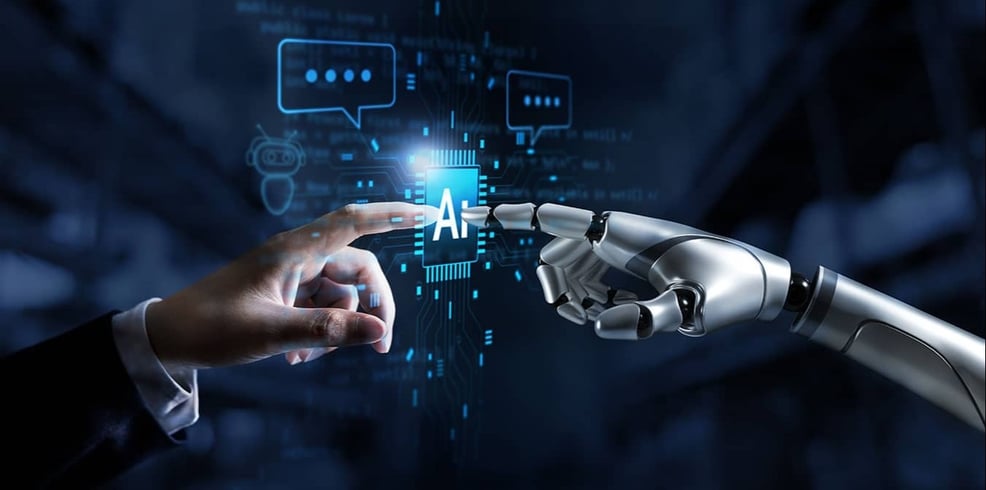AI is any technology that appears to adapt its knowledge or learns from experiences in a way that would be considered intelligent. To ensure the success of AI, UX designers use models based on social sciences and psychology, to design effective and efficient interactions. And these positive interactions enable UX designers to leverage AI for research, to generate ideas and discover new possibilities.
We will cover both the aspects:
- Design for AI: Designers setting up AI products for success.
- Design with AI: Designers using AI to augment the design process.
Design for AI
AI’s definition has centred on using computational methods to accomplish intelligent tasks. And by applying UX-centred approach to it, we are enabling users to leverage the power of AI to achieve impressive results.
Designers and Developers have big dreams for a mind-bending set of AI applications, and they can be achieved by thinking about both functions and scenarios of usage: What if we could get AI to do X and What will it be like to use AI to do X? For example: It is great to dream that the bot will convert speech to text to action, but if the speech is in a crowded bar and the speaker just had dental work, how useful is the bot?
Always start with the user – we should ask at every step - should we do it, should we build this, is it useful, is it valuable? Some of the best practices for building AI with UX can be found here: https://uxofai.com/
UX framework for AI consists of three principles: Context, Interaction and Trust.
Context
This includes the outside information that AI can use to perform a task. It includes information about the user and why they are making the request, as well as information about the external word. So, the development and design teams who work on the AI-enabled products need to understand the context of its output.
One of the most significant advantages of working with context is to design for personalized user experience. AI algorithms can analyse data from a variety of sources, such as user behaviour, demographics, and preferences, to create a highly personalized experience for each individual user. This can lead to increased engagement and satisfaction, as well as improved conversions and retention rates.
Interaction
It refers to AI engaging the user in a way in which they can respond. That engagement could come in many forms: a message in the AI’s interface, a text message, a push notification to their smartphone, news feeds, recommendations, personalised recommendations, self-driving cars etc.
The core need of UX Design for AI is to design holistic experience of interaction by focusing on affordances and signifiers to build inclusive products for everyone which should be accessible and intuitive. Affordances are point of interaction between object and perceiver that allow the perceiver to understand the object’s features. Signifiers communicate to user about capability of the object. For example: Google’s search box.
Trust
This is when users feel that an AI system will successfully perform the task that a user wants it to perform, without any unexpected outcomes. Unexpected outcomes can include performing additional tasks that breach the user’s privacy. Trust is a crucial factor for any user to adopt and stick around. Violating this principle is powerful enough to prevent users from adapting of product and trying similar but competitive products.
Therefore, it is the UX designer’s job to foster trust with users. This is harder than it sounds. We can gain users’ trust by educating and teaching users how to use the system in the best way possible. Showing users how AI works behind the scenes is a highly effective trust-building exercise. This can be done through a demo during the onboarding process.
Design with AI
Design with AI is about leveraging the Tesler’s law which states that every system has a complexity which cannot be ignored but it can be reduced by designing in a way that logical decisions should be taken by machines and creative decisions should be taken by human beings.
AI is to compliment design work not to replace design work and it should be used to design user centric experiences rather than tech centric experiences. It will help designers to get better at understanding user patterns (analysis of research done) but not Psychology or behaviour.
AI will increase the productivity, efficiency, augment natural capabilities of designers to explore options and reduce time to market.
Here’s how AI benefits design:
Let’s assume that a UX & UI designer needs to design a website for online consultation with doctors for lifestyle related diseases which are very common in metro cities due to busy and hectic schedules and lifestyle.
Below is an ideal approach that a designer will take to work with AI to augment the design process:
Step 1: Designer will tell ChatGPT about the role it needs to play. This will help ChatGPT to understand user’s perspective and respond in contextual manner.
Prompt: You are now UI/UX design research assistant
ChatGPT will confirm user about understanding the role with a message like “Of course, I can assist you with UI/UX design research! “

Benefit: Now ChatGPT is ready to play the role of a design research assistant and will answer the queries in contextual and appropriate manner which will establish designer’s trust in the system.
Step 2: To start with design process, it is very crucial for designer to build empathy. So, designer will prompt to learn about target audience and persona.
Prompt: Find target audience for online consultation service with doctors for lifestyle related diseases
Prompt: Create a persona that represent your finding from the previous prompt
For example: Below is a sample persona created by Chat GPT

Benefit: ChatGPT's output works best for Proto Personas because as per the industry wide research, quality of profiles created by ChatGPT are close to 80-90% of the personas created by traditional ways and proper user research. So, Designers can use ChatGPT in the optimal way at the initial stages of product development to create baseline proto persona.
Step 3: Designers will generate images for the Persona with image generative AI tools like Midjourney and Freepik AI.
Prompt: Sarah, 52 years old, Female, lives in Suburban area in the United States, sedentary lifestyle due to her desk job and household responsibilities
For example: Below is a sample persona image created by Freepik AI

Benefit: Image generative AIs really save time which designers spend in searching for a perfect the image on internet. And it really helps to get a customised and contextually well fit image in a very short duration.
Step 4: Designer will use AI to brainstorm about ideas to shape up the product.
Prompt: Can you describe the Information Architecture for the landing page for this business? The primary goal is to convince the user to schedule an online appointment with doctor?
For example: Below are the suggestions for Information Architecture from ChatGPT

Benefit: AI will help designers to save time to brainstorm to create the first version of list of features and information which will bring value to the landing page. Now from here designers can take creative decisions to ramp up and filter out the list.
Step 5: Designer will realise a scenario of a usage and the user flow with AI.
Prompt: Can you describe a user flow in a scenario where a user saw an ad on Facebook, and wants to schedule an appointment?
For example: Below is the response from ChatGPT:

Benefit: This response will enable designer to effectively map the touchpoints and steps which user will take to explore, schedule and avail consultation. This will help designer to gain vision about dependencies and interactions needs to be created.
Step 6: Designer will seek more inputs from AI to get relevant content to elaborate specific features and information.
Prompt: Can you provide a copy for the hero section, which includes headline, a sub headline, and the copy of the CTA button?
Prompt: Can you provide 4 more variations of copy?
Prompt: Can you provide 10 FAQs with answers?
For example: Below is the response from ChatGPT for FAQs:

Benefit: ChatGPT will not only generate the content but will also provide various versions which will provide freedom to designers to select most appropriate headline, sub headline, CTA text, description and FAQs. And designers can efficiently work without a dependency on copy writes.
Step 7: ChatGPT will help designer with the suggestions for color schemes or palette as well and that too with rationale behind it.
Prompt: Can you produce few colour schemes that would work well based on the business and the target audience?
For example: Below is a response from ChatGPT:

Benefit: Color schemes suggestions with rationale will provides more time and creative freedom to designers to experiment and design multiple versions of prototypes and test them out with real users.
AI tools can augment the UX, but the designer is the one who will run these tools with critical thinking, to design the best possible solution as per end user’s need, behaviour, and aspirations.

Varun has more than 19 years of experience in designing ‘User Experience’ and 'Human Computer Interaction’. Lead multiple design projects for world business leaders in airlines, manufacturing, and consulting domain. Follow user centred design process and facilitates discovery workshops with business and stakeholders. Pro at user research, design artefacts (persona, journey maps), usability, heuristics, sketching and prototyping. Work with lean design and agile methodology to integrate UX and deliver incremental value with every sprint.
Related reads.
About Coforge.
We are a global digital services and solutions provider, who leverage emerging technologies and deep domain expertise to deliver real-world business impact for our clients. A focus on very select industries, a detailed understanding of the underlying processes of those industries, and partnerships with leading platforms provide us with a distinct perspective. We lead with our product engineering approach and leverage Cloud, Data, Integration, and Automation technologies to transform client businesses into intelligent, high-growth enterprises. Our proprietary platforms power critical business processes across our core verticals. We are located in 23 countries with 30 delivery centers across nine countries.



